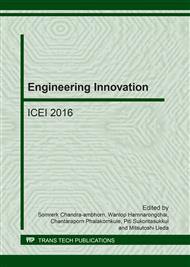[1]
A.E. Ersundu, G. Karaduman, M. C¸ elikbilek, N. Solak, S. Aydin, Stability of the δ-TeO2 Phase in the Binary and Ternary TeO2 Glasses, J Eur Ceram Soc. 30 (2010) 3087–3092.
DOI: 10.1016/j.jeurceramsoc.2010.07.018
Google Scholar
[2]
J. Ozdanova, H. Ticha, L. Tichy, Remark on the optical gap in ZnO–Bi2O3–TeO2 glasses, J Non-Cryst Solids. 353 (2007) 2799–2802.
DOI: 10.1016/j.jnoncrysol.2007.06.017
Google Scholar
[3]
P. Mosnera, K. Vosejpkova, L. Koudelka, L. Montagne, B. Revel, A review of the structures of oxide glasses by Raman spectroscopy, Mater Chem Phys. 124 (2010) 732–737.
Google Scholar
[4]
G. Gao, L. Hua, H. Fan, G. Wang, K. Li, S. Feng, S. Fan, H. Chen, J. Pan, J. Zhang, Investigation of 2. 0 μm emission in Tm3+ and Ho3+ co-doped TeO2–ZnO–Bi2O3 glasses, Opt Mater. 32 (2009) 402–405.
DOI: 10.1016/j.optmat.2009.07.003
Google Scholar
[5]
H. Lin, E.Y.B. Pun, X.R. Liu, Investigation on the Physical and Optical Properties of Dy3+Doped Soda-Lime-Silicate Glasses, J. Non-Cryst Solids. 283 (2001) 27-33.
Google Scholar
[6]
H. Jinag, Y. Jianquan, Er3+-doped tellurofluorophosphate glasses for lasers and optical amplifiers, Opt. Commun. 251 (2005) 132-138.
Google Scholar
[7]
C.H. Yeh, C.C. Lee, S. Chi, Utilizations of two-stage erbium amplifier and saturable-absorber filter for tunable and stable power-equalized fiber laser, Opt. Commun, 241 (2004) 333-338.
DOI: 10.1364/oe.15.003680
Google Scholar
[8]
S. Agrawal, V. Dubey, J. Radiat. Res. Down conversion luminescence behavior of Er and Yb doped Y2O3 phosphor, Appl Sci. 7 (2014) 601–606.
DOI: 10.1016/j.jrras.2014.09.014
Google Scholar
[9]
N. Ohashi, N. Ebisawa, T. Sekiguchi, I. Sakaguchi, Y. Wada, T. Takenaka, H. Haneda, Growth of Thick Zinc Magnesium Oxide by Liquid Phase Epitaxy, Appl Phys Lett. 86 (2005) 395-412.
DOI: 10.1063/1.1871349
Google Scholar
[10]
B. Liu, W. Ting, S. Zhen, L. Zhao-Hui, L. Jia-Xu, L. Quan-Lin, Photoluminescence properties of Ce3+ and Mn2+-activated Ba9Sc2Si6O24 phosphor for white light emitting diodes, Chin Phys B. 22 (2013) 779-801.
Google Scholar
[11]
J.S. Kim, J.Y. Kang, P.E. Jeon, J.C. Choi, H.L. Park, T.W. Kim, Ca7. 97- xMg(SiO4)4Cl2: Eu0. 03, Dx (D=Y, Gd, Mn) Phosphor Particles Prepared by Spray Pyrolysis, Jpn J Appl Phys. 43 (2004) 989-995.
Google Scholar
[12]
Z. Yong, H. Qiong, N. Qiao-Li, Z. Shu-Wen, L. Shu-Ti, H. Miao, F. Guang-Han Chin, Synthesis and down-conversion luminescence properties of Er3+/Yb3+ co-doped AlF3-PbF2-CaF2 powders, Phys Lett. 26 (2009) 811-819.
DOI: 10.1016/j.optmat.2015.04.004
Google Scholar
[13]
C. Ming, F. Song, L. An, X. Ren, Controllable photoluminescence by melting-process temperature in SnO-containing glass, Mater Lett. 137 (2014) 117–119.
Google Scholar
[14]
B. Dong, D.P. Liu, X.J. Wang, T. Yang, S.M. Miao, C.R. Li, Optical thermometry through infrared excited green upconversion emissions in Er3+–Yb3+Er3+–Yb3+ codoped Al2O3, Appl Phys Lett. 90 (2007) 117-123.
DOI: 10.1063/1.2735955
Google Scholar
[15]
B. Wang, R.M. Guo, X.J. Wang, L. Wang, Z. Zhou, Composition dependence of the Yb-participated strong up-conversions in polycrystalline ErYb silicate, Opt Mater. 34 (2012)1289–1293.
DOI: 10.1016/j.optmat.2012.02.001
Google Scholar
[16]
B.S. Cao, Y.Y. He, L. Zhang, B. Dong, Upconversion properties of Er3+–b3+: NaYF4 phosphors with a wide range of Yb3+ concentration, J Lumin. 135 (2013) 128–132.
DOI: 10.1016/j.jlumin.2012.10.031
Google Scholar
[17]
J. Yang, S. Xiao, J. Ding, X. Yang, X. Wang, J, Preparation and photoluminescence properties of SrY2O4: Yb3+, Er3+ powders, Alloys Compd. 474 (2009) 424–427.
DOI: 10.1016/j.jallcom.2008.06.158
Google Scholar
[18]
J. Sokolnicki, Upconversion Luminescence from Er3+ in Nanocrystalline Y2Si2O7: Er3+ and Y2Si2O7: Yb3+Er3+ Phosphors, Mater Chem Phys. 131 (2011) 306–312.
DOI: 10.1016/j.matchemphys.2011.09.046
Google Scholar
[19]
Y. Dwivedi, K. Mishra, S.B. Rai, Synthesis and down-conversion luminescence properties of Er3+/Yb3+ co-doped AlF3-PbF2-CaF2 powders, J. Alloys Compd. 572 (2013) 90–96.
DOI: 10.1016/j.optmat.2015.04.004
Google Scholar
[20]
S.F. Zou, Z.L. Zhang, F. Zhang, Y.L. Mao, High efficient quantum cutting in Ce3+/Yb3+co-doped oxyfluoride glasses, J Alloys Compd. 572 (2013) 110–112.
DOI: 10.1016/j.jallcom.2013.03.287
Google Scholar
[21]
B. Tian, B. Chen, Y. Tian, J. Sun, X. Li, J. Zhang, H. Zhong, L. Cheng, Z. Wu, R. Hua, Visible quantum cutting in BaGd2ZnO5: Eu3+ phosphor, Ceram Int. 38 (2012) 3537–3540.
DOI: 10.1016/j.ceramint.2011.12.068
Google Scholar
[22]
B. Liu, Y. Chen, C. Shi, H. Tang, Y. Tao, Visible quantum cutting in BaF2: Gd, Eu via downconversion, J Lumin. 101 (2003) 155–159.
DOI: 10.1016/s0022-2313(02)00408-8
Google Scholar
[23]
Maurice, E., Monnom, G., Dussardier, B., Saissy, A., Ostrowsky, D.B., Baxter G.W., Erbium-doped silica fibers for intrinsic fiber-optic temperature sensors, Applied Optics. 34 (1995) 8019-8025.
DOI: 10.1364/ao.34.008019
Google Scholar


